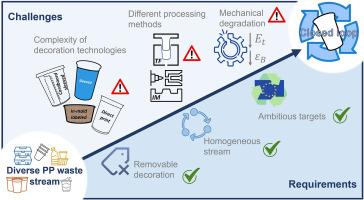设计和制造的多样性破坏了循环性:简单酸奶杯的案例
IF 11.2
1区 环境科学与生态学
Q1 ENGINEERING, ENVIRONMENTAL
引用次数: 0
摘要
回收利用倡议的目标是提高回收利用率和闭合包装循环,但实际、政治和工业方面的挑战可能仍未引起人们的注意。本研究深入探讨了聚丙烯(PP)聚合物流,尤其是酸奶杯的机械、加工和形态差异。废物来源(混合城市生活垃圾或塑料收集)对机械性能的影响不大。然而,对聚丙烯包装多样性的分析却让人怀疑能否获得高质量的回收物。分类尝试包括热成型、注塑成型和共聚物。理想化的酸奶杯流显示了各种装饰技术和加工方法的复杂性。在酸奶杯的闭环系统中,热成型和注塑成型至关重要,这促使人们模仿原生和消费后的杯子材料。70 wt.%的临界值和劣化效应与常见的填料和聚合物一起被确定下来。随着高质量再造粒变得越来越重要,我们还必须考虑加工方法的影响,并以获得清洁、均匀的原料流为目标。本文章由计算机程序翻译,如有差异,请以英文原文为准。

Design and manufacturing diversity undermine circularity: The case of a simple yogurt cup
Recycling initiatives target increased recycling rates and closing packaging loops, yet practical, political, and industrial challenges may remain unnoticed. This study delves into the mechanical, processing, and morphological disparities within a polypropylene (PP) polymer stream, especially for yogurt cups. The waste source (mixed MSW or plastic collection) does not considerably impact mechanical properties. However, analyzing PP packaging diversity raises doubts about achieving high-quality recyclate. Categorization attempts include thermoforming, injection molding, and copolymers. An idealized stream of yogurt cups reveals complexities due to various decoration technologies and processing methods. Within a closed-loop system for yogurt cups, thermoforming and injection molding are crucial, prompting the imitation of virgin and post-consumer cup materials. A threshold value of 70 wt.% and deterioration effects are identified alongside common fillers and polymers. As high-quality regranulate becomes increasingly essential, we must also consider the effects of processing methods and aim for a clean, homogeneous stream.
求助全文
通过发布文献求助,成功后即可免费获取论文全文。
去求助
来源期刊

Resources Conservation and Recycling
环境科学-工程:环境
CiteScore
22.90
自引率
6.10%
发文量
625
审稿时长
23 days
期刊介绍:
The journal Resources, Conservation & Recycling welcomes contributions from research, which consider sustainable management and conservation of resources. The journal prioritizes understanding the transformation processes crucial for transitioning toward more sustainable production and consumption systems. It highlights technological, economic, institutional, and policy aspects related to specific resource management practices such as conservation, recycling, and resource substitution, as well as broader strategies like improving resource productivity and restructuring production and consumption patterns.
Contributions may address regional, national, or international scales and can range from individual resources or technologies to entire sectors or systems. Authors are encouraged to explore scientific and methodological issues alongside practical, environmental, and economic implications. However, manuscripts focusing solely on laboratory experiments without discussing their broader implications will not be considered for publication in the journal.
 求助内容:
求助内容: 应助结果提醒方式:
应助结果提醒方式:


